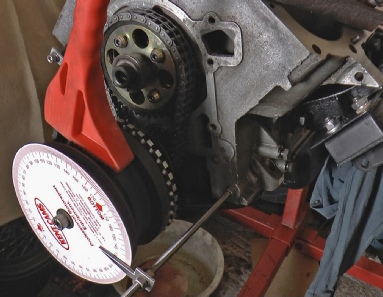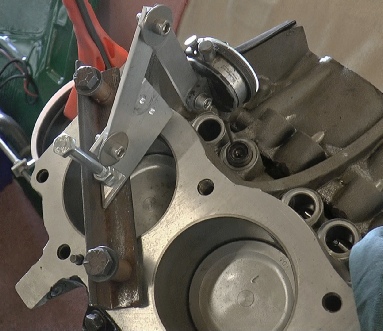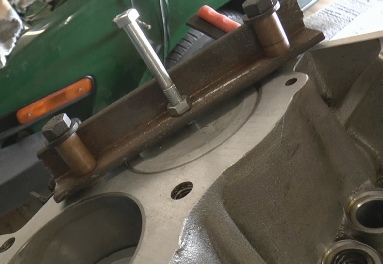 Home
Home



Cam timing





An interesting description of how to carry out this process can be found on the V8 Developments web site. I have a standard crank which should give maximum valve lift on number one cylinder at 112.5 degrees after top dead centre so that’s what I was aiming at. Also my sprocket is adjusted by loosening four clamping bolts. There are other ways that have been adopted.
First I drilled and tapped a hole in a crankshaft bolt and using a long screw (or a piece of studding -
I used a tool similar to an oil filter remover (a large rubber band grips the crank pulley and tightens as you use the red lever to turn the crank. To start with, it doesn’t matter where the pointer is pointing on the wheel.
The next task is to find top dead centre on number one cylinder. I drilled holes in a piece of steel spaced to fit the head bolt holes as shown in the picture on the left. I drilled and tapped a hole for a bolt in the centre. I bolted the whole thing onto the block with a washer between the steel and the block to prevent marking.
Next I turned the crank so that it was just below what I judged TDC to be by eye. I screwed the bolt down to just touch the piston and secured it in place with a lock nut. I then tried to turn the crank to make sure it was really up against the bolt.
I then noted down the reading on the degree wheel. I then tuned the crank in the opposite direction until the piston again was firmly up against the bolt. I then read off the position of the pointer against the wheel. TDC will be exactly half way between the two readings.
Now loosen the bolt and turn the crank so that the pointer registers that halfway position which will leave it at TDC. Now, without allowing the crank to move, loosen the degree wheel and turn it so the pointer is at zero and, without allowing anything to shift, secure the degree wheel to the crank again. Check agin to make sure your position is correct. Now TDC or any before or after position can be accurately set or measured.
Now using a homemade arm, I secured a dial gauge so it rested on the top of a tappet in number one cylinder inlet valve when the tappet was rising. Make sure as you turn the engine that the dial gauge is in a position to accommodate all the movement of the tappet and does not jam and bend something. Turn the engine clockwise looking at the engine from the front. Don’t turn it backwards otherwise the backlash in the chain will not be correctly taken up.
With the tappet rising and checking that the dial is moving (ie. it’s in contact with the tappet), turn the crank until the protractor reads 105 degrees after TDC. Now turn the ring on the dial gauge (without disturbing its position) so that the needle is on zero. Now turn the crank slowly forward. The needle reading should increase to a maximum the reduce again. When it’s at zero again, take the reading on the protractor. The peak point will be halfway between 105 and whatever the last reading was. (Add the two readings together and divide by 2.) Hopefully it will be 112.5 which is the timing for a standard camshaft. So the reading on the protractor should have been 120 degrees: (105 + 120)/2 = 112.5.
If this is not the case, the bolts on the camshaft sprocket will have to be loosened and an adjustment made.
Suppose the second reading was 125 degrees. That would make the peak came in at (105 + 125)/2 = 115 degrees. This means the crank needs to go back 115 -
Next comes the exhaust…
Finding TDC
Loosen these bolts to adjust

Crankshaft protractor
Dial gauge in position